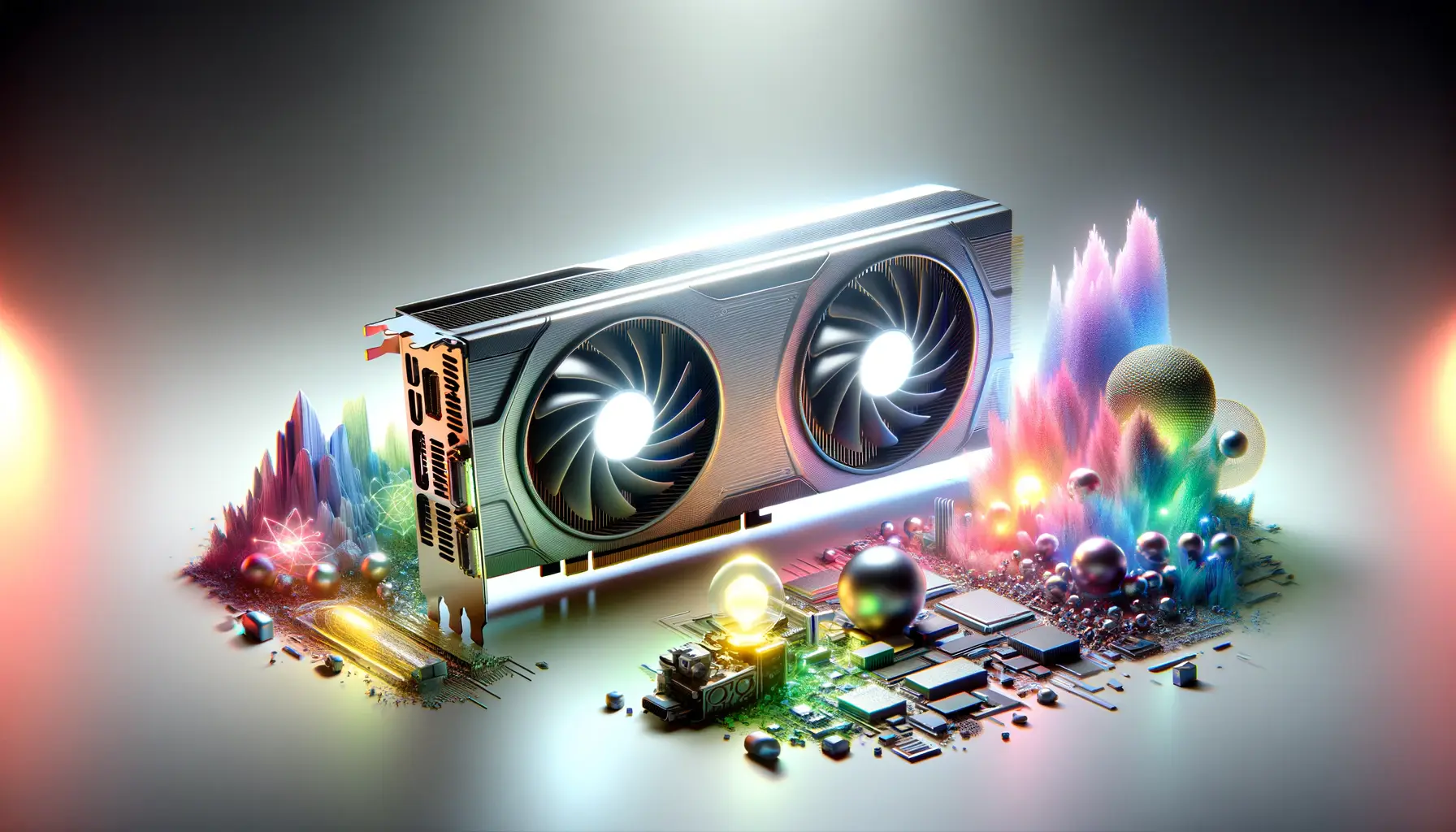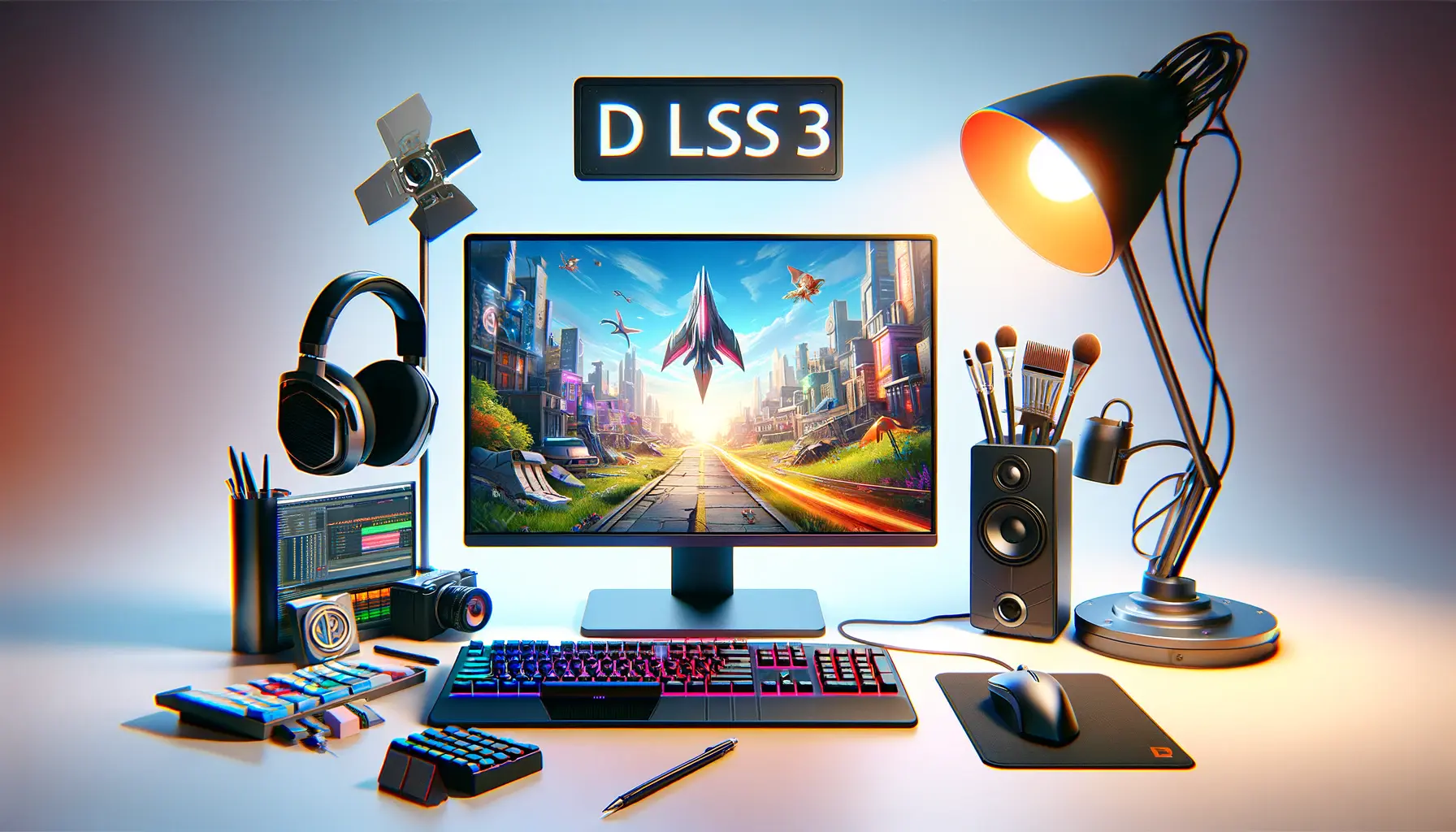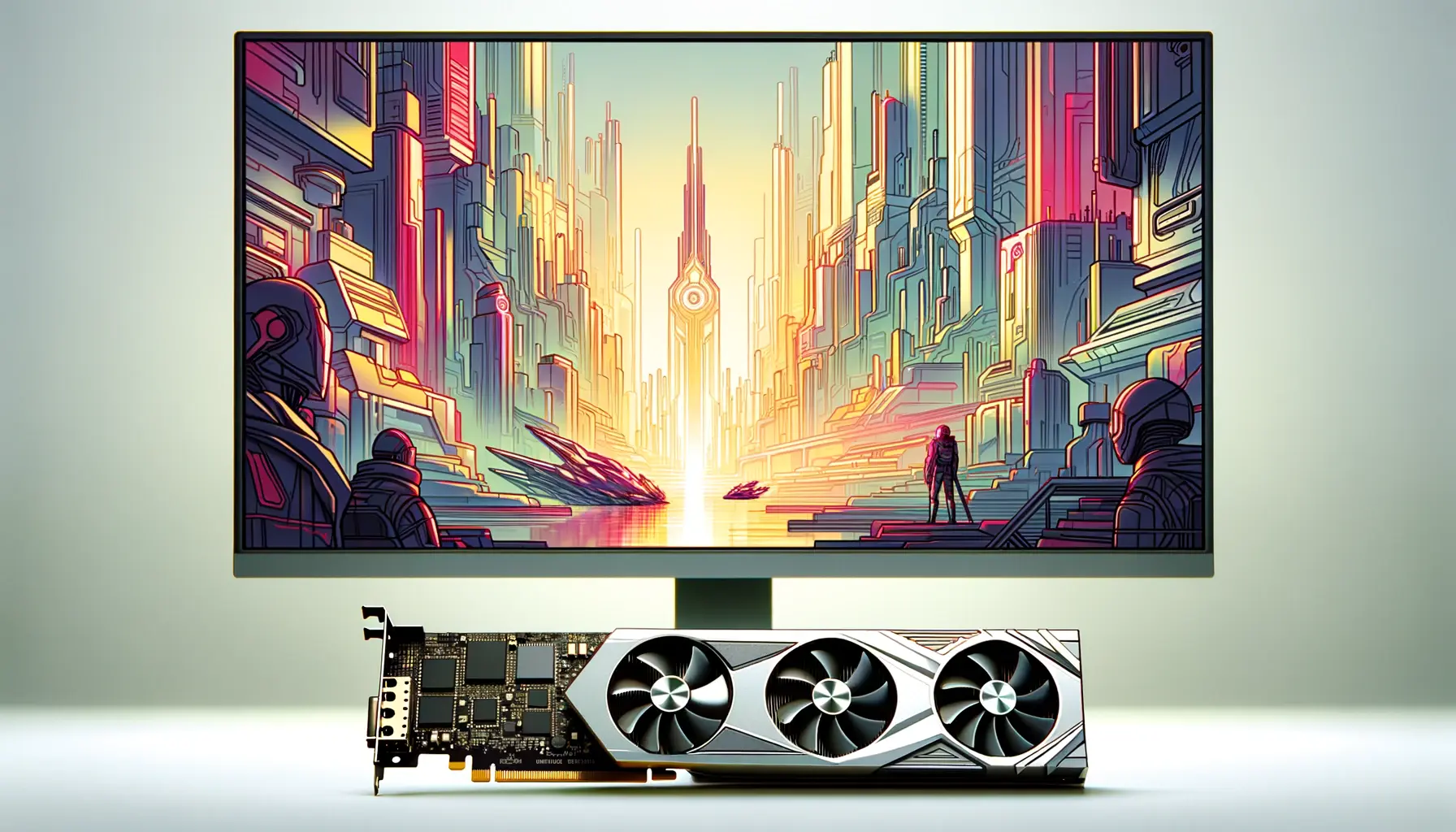The advent of Deep Learning Super Sampling (DLSS) technology by NVIDIA has marked a significant milestone in the realm of video gaming and game design.
DLSS 3, the latest impact, stands at the forefront of this innovation, promising to redefine the boundaries of gaming performance and visual fidelity.
This technology, by leveraging artificial intelligence and machine learning, not only enhances the gaming experience for players but also opens new avenues for game developers in terms of design and creativity.
At its core, DLSS 3 utilizes advanced AI algorithms to upscale lower-resolution images in real-time, presenting them in higher fidelity without the traditional computational cost.
This breakthrough means games can run at higher frame rates while maintaining, or even improving, the quality of the visuals.
For gamers, this translates to smoother, more immersive experiences even on hardware that would otherwise struggle to maintain performance with high-resolution settings.
For developers, it offers the flexibility to push the envelope of graphical quality and complex game design without alienating players with less powerful systems.
- Game Performance and Quality
- Implications for Game Development
- DLSS 3 and the Future of Gaming
- Challenges and Considerations in Implementing DLSS 3
- DLSS 3 in Competitive Gaming
- DLSS 3 and Game Streaming Services
- DLSS 3’s Role in Virtual Reality Gaming
- Embracing the Future with DLSS 3
- DLSS 3: Frequently Asked Questions
Game Performance and Quality
The Mechanics of DLSS 3
DLSS 3 operates by interpolating frames using AI-driven predictions, effectively generating additional frames between existing ones to boost performance.
This process, known as frame generation, is a cornerstone of DLSS 3, enabling games to achieve fluid motion and high frame rates without compromising on visual quality.
The technology leverages NVIDIA’s Tensor Cores, specialized hardware found in RTX series GPUs, to perform these calculations efficiently, ensuring that the upscaling process does not become a bottleneck for performance.
One of the key benefits of DLSS 3 is its adaptability.
The technology dynamically adjusts its processing based on the complexity of the scene being rendered, ensuring optimal performance across a wide range of gaming titles.
This adaptability extends to support for various resolutions and aspect ratios, making DLSS 3 a versatile tool in a developer’s arsenal for achieving desired performance targets across different gaming platforms.
Enhancing Visual Fidelity
DLSS 3 not only boosts frame rates but also enhances the visual quality of games.
By utilizing deep learning to upscale images, it reduces the artifacts typically associated with traditional upscaling methods, such as blurring and aliasing.
This results in crisper textures, smoother edges, and more detailed environments, contributing to a more immersive gaming experience.
The technology’s ability to maintain high visual fidelity at lower native resolutions allows developers to incorporate more detailed models and textures without the fear of performance hits.
Furthermore, the introduction of DLSS 3 has significant implications for ray tracing, a rendering technique that simulates the physical behavior of light to achieve real-time global illumination, reflections, and shadows.
Ray tracing is computationally intensive, but with DLSS 3, games can now leverage this technology more freely.
Developers can design games with realistic lighting and shadows, knowing that DLSS 3 will help maintain a smooth gameplay experience.
DLSS 3 represents a leap forward in balancing performance with visual quality, enabling more gamers to enjoy high-fidelity visuals without needing top-tier hardware.
Implications for Game Development
The integration of DLSS 3 into the game development process heralds a transformative shift in how developers approach game design and optimization.
With the ability to render games at lower resolutions while delivering high-quality visuals, developers can now prioritize adding complexity and detail to their games without the constant worry of performance trade-offs.
This section delves into the multifaceted impact of DLSS 3 on game development, from enhancing creative freedom to streamlining the development workflow.
Expanding Creative Boundaries
DLSS 3 empowers developers to push the boundaries of creativity and innovation in game design.
The technology’s capability to maintain smooth performance while rendering detailed and complex scenes allows for:
- More intricate game environments: Developers can design richer, more detailed worlds, packed with high-resolution textures and complex geometry, without compromising on performance.
- Advanced visual effects: The efficiency of DLSS 3 enables the inclusion of sophisticated visual effects, such as dynamic lighting, volumetric fog, and particle effects, enhancing the game’s atmosphere and immersion.
Optimizing Development Workflow
DLSS 3 not only enhances the gaming experience but also optimizes the development workflow, offering several key benefits:
- Reduced need for optimization: The performance gains provided by DLSS 3 reduce the time and resources developers need to spend on performance optimization, allowing them to focus more on content creation and game design.
- Streamlined testing processes: With DLSS 3 ensuring consistent performance across a wide range of hardware, developers can streamline their testing processes, reducing the need for extensive testing on different configurations.
Moreover, DLSS 3’s adaptability to various resolutions and aspect ratios simplifies the process of developing games for multiple platforms.
This versatility ensures that games can deliver a consistent experience across desktops, laptops, and potentially future cloud gaming platforms, broadening the audience reach.
The advent of DLSS 3 is a game-changer for the industry, offering a blend of performance optimization and visual enhancement that significantly impacts game development and design.
DLSS 3 and the Future of Gaming
The introduction of DLSS 3 by NVIDIA is not just a current enhancement to gaming technology; it’s a glimpse into the future of gaming.
As we stand on the brink of new advancements in hardware and software, DLSS 3 serves as a beacon, showcasing what is possible when combining AI with real-time graphics rendering.
This technology not only improves the gaming experience today but also sets the stage for future innovations in the gaming industry.
Looking ahead, the potential applications and developments stemming from DLSS 3 technology are vast.
From its impact on gaming hardware to its influence on game design and player experiences, DLSS 3 is poised to shape the future landscape of gaming in several key ways.
Enabling Next-Gen Gaming Hardware
- Lower Hardware Requirements: By efficiently upscaling lower-resolution images, DLSS 3 allows gamers to experience high-quality visuals without the need for cutting-edge hardware, making high-end gaming more accessible.
- Extended Hardware Lifespan: DLSS 3 extends the relevance and performance lifespan of existing hardware, allowing gamers to enjoy new titles at high settings without frequent upgrades.
Shaping Game Design and Development
- Increased Graphical Fidelity: Developers can leverage DLSS 3 to create games with unprecedented graphical detail and complexity, knowing that performance can be maintained across a broad spectrum of hardware.
- Enhanced Immersion and Realism: With the ability to incorporate advanced lighting, shadows, and effects without performance penalties, games can offer more immersive and realistic environments.
Improving Player Experiences
- Smoother Gameplay: DLSS 3’s frame generation and upscaling result in higher frame rates and smoother gameplay, enhancing the overall gaming experience.
- Broader Accessibility: The performance benefits of DLSS 3 make demanding games more accessible to players with mid-range hardware, expanding the gaming community.
The trajectory of DLSS 3 and its impact on the gaming industry suggests a future where the lines between reality and virtual environments become increasingly blurred.
As this technology continues to evolve, we can anticipate further innovations that will redefine the standards of gaming performance and visual quality.
DLSS 3 is not just a technological advancement; it’s a vision for the future of gaming, where AI and machine learning play pivotal roles in shaping immersive, accessible, and visually stunning gaming experiences.
Challenges and Considerations in Implementing DLSS 3
While DLSS 3 offers significant advantages in terms of performance and visual quality, its implementation is not without challenges and considerations.
Developers and gamers alike must navigate various factors to fully leverage the benefits of this technology.
Understanding these challenges is crucial for optimizing DLSS 3’s potential and ensuring it delivers on its promise to enhance the gaming experience.
From technical requirements to the balance between performance and fidelity, several key issues must be addressed to maximize the effectiveness of DLSS 3 in game development and gameplay.
Technical Integration and Compatibility
- Hardware Requirements: DLSS 3 is designed to run on NVIDIA’s RTX series GPUs, which means its benefits are not accessible to users with older or non-NVIDIA graphics cards. This limitation can affect the universality of gaming experiences across different hardware setups.
- Development Complexity: Integrating DLSS 3 into games requires a certain level of technical expertise and familiarity with NVIDIA’s development tools. This complexity can pose a barrier for smaller development teams or indie developers with limited resources.
Performance vs. Visual Fidelity
- Finding the Right Balance: While DLSS 3 significantly improves frame rates, achieving the perfect balance between performance and visual fidelity can be challenging. Developers must fine-tune DLSS settings to ensure that the upscaling process does not compromise the game’s visual quality.
- Player Preferences: Gamers have diverse preferences regarding visual quality and performance. Some may prioritize frame rates over graphical fidelity, while others prefer the opposite. Offering customizable DLSS settings can help cater to this wide range of preferences.
Future-Proofing and Evolution
- Adapting to Future Technologies: As gaming technology continues to evolve, ensuring that DLSS 3 remains compatible and effective with new hardware and software advancements is essential. NVIDIA and developers must work together to update and refine DLSS technology in response to industry changes.
- Expanding Support: Broadening DLSS 3 support to more games and platforms is crucial for its widespread adoption. This expansion requires ongoing collaboration between NVIDIA, game developers, and platform providers to integrate DLSS technology seamlessly across the gaming ecosystem.
Addressing these challenges is essential for harnessing the full potential of DLSS 3.
By navigating these considerations thoughtfully, developers can optimize the implementation of DLSS 3, ensuring that it enhances gaming experiences for all players, regardless of their hardware or preferences.
Effective implementation of DLSS 3 requires careful consideration of technical, aesthetic, and future-proofing challenges to ensure it delivers enhanced gaming experiences to a broad audience.
DLSS 3 in Competitive Gaming
The rise of competitive gaming and esports has placed an unprecedented emphasis on performance, with players seeking every possible advantage to gain the upper hand.
In this high-stakes environment, technologies like DLSS 3 are scrutinized for their impact on gameplay, particularly regarding latency and visual clarity.
The integration of DLSS 3 into competitive gaming presents both opportunities and challenges, as players balance the desire for smooth performance with the need for precise visual information.
Understanding the nuances of DLSS 3’s impact on competitive gaming requires a deep dive into its benefits and potential drawbacks in scenarios where every millisecond counts.
Enhancing Performance in Competitive Play
- Higher Frame Rates: One of the most significant advantages of DLSS 3 for competitive gamers is the substantial increase in frame rates. Higher frame rates contribute to smoother gameplay, which is crucial in fast-paced competitive settings where split-second reactions can determine the outcome of a match.
- Reduced Input Lag: Although DLSS 3’s frame generation process introduces additional computational steps, NVIDIA’s Reflex technology aims to counteract potential increases in input lag. For competitive gamers, minimizing input lag is essential for maintaining responsiveness and control during gameplay.
Visual Fidelity vs. Competitive Advantage
- Maintaining Visual Clarity: In competitive gaming, the clarity of visual information is paramount. Players need to quickly identify and react to enemies, projectiles, and environmental cues. DLSS 3’s upscaling process must preserve critical visual details without introducing artifacts that could hinder player performance.
- Customizable Settings: Offering players the ability to customize DLSS settings allows them to find the optimal balance between performance and visual quality. Competitive gamers may prefer settings that prioritize frame rates and responsiveness, while others might opt for higher visual fidelity.
Adoption and Acceptance in the Esports Community
- Community Perception: The adoption of DLSS 3 in competitive gaming largely depends on its reception by the esports community. Players and teams will weigh the technology’s benefits against any perceived disadvantages, such as potential impacts on game balance or fairness.
- Integration in Esports Titles: For DLSS 3 to become a staple in competitive gaming, it must be integrated into popular esports titles. Developers of these games will need to work closely with NVIDIA to ensure that DLSS 3 enhances the competitive experience without compromising game integrity.
As competitive gaming continues to evolve, technologies like DLSS 3 will play a pivotal role in shaping the future of esports.
Balancing performance enhancements with the need for precision and fairness will be crucial for DLSS 3’s successful integration into the competitive gaming landscape.
DLSS 3 offers significant benefits for competitive gaming, including higher frame rates and reduced input lag, but its adoption depends on maintaining visual clarity and ensuring a level playing field for all competitors.
DLSS 3 and Game Streaming Services
The integration of DLSS 3 into game streaming services marks a pivotal evolution in cloud gaming, offering a solution to one of the most significant challenges: delivering high-quality gaming experiences over the internet.
As streaming services strive to provide games at the highest possible fidelity without latency or loss of detail, DLSS 3 emerges as a key technology that can bridge the gap between the cloud gaming vision and its practical implementation.
This section explores how DLSS 3 enhances game streaming services, improving both the quality of streamed content and the overall user experience, making high-end gaming more accessible to a broader audience.
Boosting Stream Quality and Performance
- Enhanced Visual Quality: DLSS 3’s ability to upscale images in real-time allows game streaming services to deliver higher-resolution content without requiring more bandwidth. This means that gamers can enjoy crisp, detailed visuals even when streaming games at lower native resolutions.
- Reduced Bandwidth Requirements: By transmitting lower-resolution streams that are upscaled on the client side using DLSS 3, streaming services can significantly reduce their bandwidth usage. This not only improves the efficiency of data transmission but also makes high-quality gaming more feasible for users with limited internet speeds.
Expanding Accessibility to High-End Gaming
- Lower Hardware Barriers: DLSS 3 enables game streaming services to offer high-end gaming experiences on devices that lack powerful hardware. This technology democratizes access to the latest games, allowing them to be played on laptops, tablets, and even smartphones.
- Seamless Gaming Across Devices: With DLSS 3, gamers can experience consistent visual quality and performance across different devices. This flexibility enhances the appeal of game streaming services, catering to the growing trend of gaming on the go.
Challenges in Implementing DLSS 3 for Streaming
- Dependency on NVIDIA Hardware: The requirement for NVIDIA’s RTX GPUs on the client side to utilize DLSS 3 could limit the technology’s applicability in game streaming, where diverse devices are used. Overcoming this challenge requires innovative solutions to make DLSS 3’s benefits more universally accessible.
- Optimizing for Varied Network Conditions: Ensuring that DLSS 3-enhanced streams deliver consistent quality across different network conditions is crucial. Streaming services must adaptively manage stream quality and DLSS settings in real-time to provide the best possible experience for each user.
As game streaming services continue to evolve, integrating technologies like DLSS 3 will be key to overcoming the limitations of cloud gaming.
By enhancing visual quality, reducing bandwidth requirements, and making high-end gaming more accessible, DLSS 3 has the potential to significantly impact the future of game streaming.
Integrating DLSS 3 into game streaming services can transform the cloud gaming landscape, offering enhanced visual quality and performance while making high-end gaming accessible to a wider audience.
DLSS 3’s Role in Virtual Reality Gaming
Virtual Reality (VR) gaming stands as one of the most immersive experiences available to gamers, demanding not only high frame rates but also exceptional visual fidelity to maintain immersion and prevent discomfort.
DLSS 3, with its advanced AI-driven upscaling and frame generation capabilities, plays a crucial role in pushing the boundaries of what’s possible in VR gaming.
It addresses the dual challenge of delivering both performance and visual quality, which are critical for a seamless VR experience.
This exploration into DLSS 3’s impact on VR gaming sheds light on how this technology enhances the virtual realm, making it more accessible and enjoyable for gamers worldwide.
Improving VR Game Performance
- Higher Frame Rates: In VR, maintaining high frame rates is essential to prevent motion sickness and ensure a smooth experience. DLSS 3’s frame generation technology significantly boosts frame rates, making VR gaming more comfortable and reducing the risk of discomfort for players.
- Enhanced Visual Clarity: DLSS 3 improves the clarity of VR games by upscaling lower-resolution images to higher fidelity. This enhancement is particularly beneficial in VR, where visual detail contributes to the depth and immersion of the virtual environment.
Enabling More Complex VR Worlds
- Richer Environments: With the performance benefits provided by DLSS 3, developers can create more detailed and complex VR worlds without worrying about performance penalties. This capability allows for richer storytelling and more engaging VR experiences.
- Advanced Effects: DLSS 3 enables the inclusion of advanced graphical effects in VR games, such as realistic lighting and shadows, without compromising frame rates. These effects add to the realism and immersion of VR gaming, making virtual worlds more convincing.
Challenges and Future Directions
- Latency Considerations: While DLSS 3 improves frame rates, it’s essential to manage latency effectively to ensure responsive VR experiences. Ongoing optimizations and advancements in DLSS technology will be crucial to minimize latency and maintain the immersive quality of VR gaming.
- Wider Adoption in VR Development: For DLSS 3 to have a transformative impact on VR gaming, its adoption among VR game developers needs to increase. As more developers integrate DLSS 3 into their VR titles, players can expect a significant uplift in the quality and performance of VR games.
DLSS 3 represents a significant advancement for VR gaming, offering solutions to some of the most pressing challenges in the field.
By enhancing performance, visual fidelity, and enabling more complex virtual environments, DLSS 3 is set to play a pivotal role in the evolution of VR gaming.
As this technology continues to develop, its potential to redefine virtual reality experiences is immense, promising a future where VR gaming is more immersive, accessible, and visually stunning than ever before.
The misconception that VR gaming is limited by current hardware capabilities is challenged by DLSS 3, which demonstrates that advanced AI technologies can significantly enhance VR experiences.
Embracing the Future with DLSS 3
The journey through the realms of gaming, from high-stakes competitive arenas to the boundless universes of virtual reality, reveals the transformative impact of DLSS 3.
This advanced technology, by harnessing the power of AI, has not only redefined the benchmarks for performance and visual fidelity but also broadened the horizons for game developers and players alike.
As we stand on the cusp of new digital frontiers, DLSS 3 emerges as a pivotal force in shaping the future of gaming.
The Catalyst for Enhanced Gaming Experiences
DLSS 3’s role in elevating gaming experiences cannot be overstated.
By intelligently balancing the scales of performance and visual quality, it ensures that gamers no longer have to compromise on one to enjoy the other.
This equilibrium is particularly crucial in the competitive gaming scene, where DLSS 3’s contribution to higher frame rates and reduced latency can be the difference between victory and defeat.
Moreover, its impact extends beyond the screens, influencing the very design and development of games, enabling creators to envision and craft worlds with unprecedented detail and complexity.
Charting the Path Forward
- The democratization of high-end gaming, making it accessible to a wider audience regardless of their hardware capabilities.
- A shift in the development paradigm, encouraging the creation of more visually stunning and complex games without the fear of performance bottlenecks.
- The potential for groundbreaking advancements in virtual reality, pushing the boundaries of immersion and interactivity.
In essence, DLSS 3 is not just a technological innovation; it’s a beacon that guides the gaming industry towards a future where the limits of creativity and performance are continually expanded.
As we look ahead, the ongoing evolution of DLSS technology promises even greater possibilities, from enhancing cloud gaming services to redefining virtual reality experiences.
The journey with DLSS 3 is just beginning, and its full impact on the gaming landscape is yet to be realized.
In conclusion, DLSS 3 stands as a testament to the power of AI in revolutionizing gaming.
It encapsulates the aspirations of gamers and developers for higher-quality, more accessible, and deeply immersive gaming experiences.
As we embrace the future with DLSS 3, we step into a new era of gaming, marked by boundless possibilities and the promise of even more extraordinary advancements on the horizon.
DLSS 3: Frequently Asked Questions
Explore the most common inquiries about NVIDIA’s groundbreaking DLSS 3 technology and its impact on gaming.
DLSS 3 combines AI-driven frame generation with super resolution and NVIDIA Reflex to boost game performance and visual quality on RTX 40 Series GPUs.
DLSS 3 is supported exclusively on NVIDIA GeForce RTX 40 Series GPUs, leveraging their advanced AI processing capabilities.
While DLSS 3 significantly enhances performance, its effectiveness varies by game, depending on the title’s support and optimization for the technology.
DLSS 3 can introduce minimal latency due to frame generation, but NVIDIA Reflex technology is employed to mitigate this and ensure responsive gameplay.
DLSS 3 enhances visual quality by upscaling images with AI, producing sharper and more detailed visuals without the high computational cost of native resolutions.
Yes, DLSS 3 is particularly beneficial for VR gaming, offering higher frame rates and improved visual fidelity, crucial for an immersive VR experience.
DLSS 3 can be used in competitive gaming to enhance performance, though players may adjust settings to balance between frame rates and visual fidelity.
DLSS 3 can improve the quality of game streaming services by allowing for higher resolution gameplay with lower bandwidth requirements.












